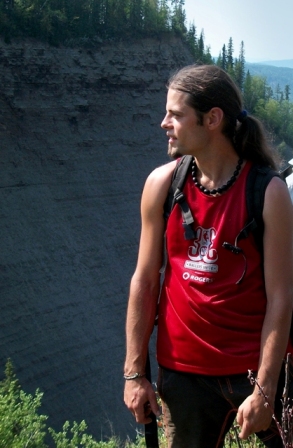Biography:
Piotr Angiel is working on his PhD’s project at the University of Western Ontario under the supervision of Dr. Guy Plint. He grew up in Gdansk and Warsaw in Poland. He received his both MSc degrees at University of Warsaw in Poland. His research in both MSc projects were directed towards an understanding of the dynamics and processes of various sedimentary environments: modern braided rivers on Iceland, barchan dunes in Mongolia, and early Holocene parabolic dune sediments in Central Poland.
The scientific experience that he gained was very useful during his work at the Polish Antarctic Station on King George Island (West Antarctica). During over two years of field research in Antarctica he was involved in a range of geological, geographical and biological projects, broadly focused on sedimentation processes, past glaciations, and impact of climatic changes on glacier extent, plant communities and penguin populations in Maritime Antarctica. His interests include photography, traveling, cycling and basketball.
Project: Allostratigraphy, Sedimentology and Paleogeography of the Cretaceous Upper Fort St. John Group (Upper Albian-Lower Cenomanian) in Northeastern British Columbia
The project is concerned with high-resolution allostratigraphy, tectonic controls and paleogeography of the Cretaceous Upper Fort St. John Group (Hasler, Goodrich and Cruiser formations) in the proximal foredeep of the Western Canada Foreland Basin, NE British Columbia. This area presents a rare opportunity to observe a very expanded Albian shallow marine succession that affords a 450 km long E-W transect from foredeep to forebulge, within which lateral facies transitions have been little disturbed by tectonism. The objective of the project is to understand lateral changes in rock type, and to relate these changes to variations in the rate of basin subsidence, sediment supply, and sea-level change. It is important to understand mechanisms of sediment dispersal and deposition if the distribution of sedimentary rock types is to be understood. Such an understanding allows better predictive models to be developed, and hence economic prospects to be better evaluated.
The sedimentology and stratigraphy of mudstone is presently a topic of intense interest, driven by the phenomenal rise in the economic potential of shale gas. The Upper Fort St. John Group constitutes an ideal natural laboratory in which to study patterns and mechanisms of mud dispersal across an ancient shallow marine ramp. In particular, the relative importance of mud transport by storm-driven geostrophic flows, versus wave-supported gravity-driven flows will be investigated. Two specific, and contrasting economic aspects are relevant to this project: First, the study encompasses the ‘Fish Scales sandstone’ which is a very organic-rich unit with the potential to source hydrocarbons and host shale gas; Secondly, the nearshore sandstone facies (Goodrich Formation) are presently being exploited (e.g. by Talisman) as shallow subsurface sources of water for injection into deeper hydrocarbon-producing horizons. Not all sandstones produce water equally well, and hence an understanding of facies character may improve our ability to choose successful horizons to perforate.
